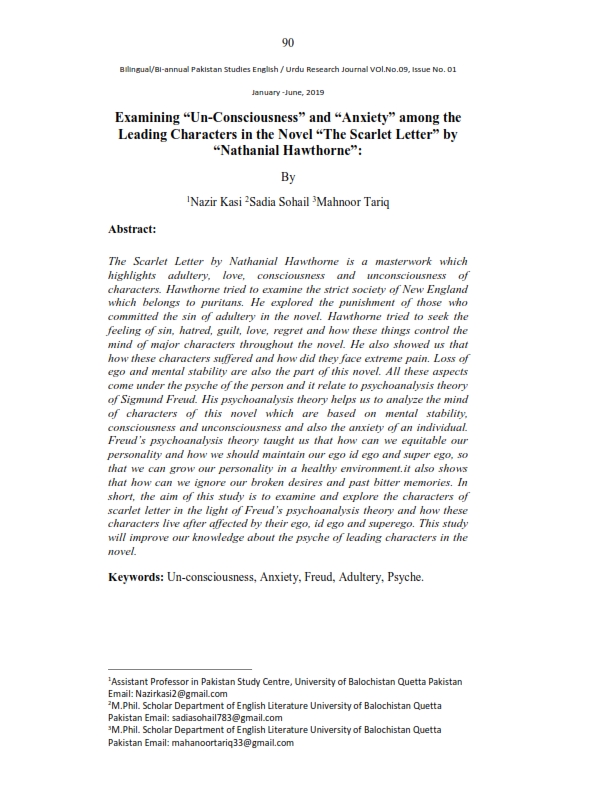Examining “Un-Consciousness” and “Anxiety” among the Leading Characters in the Novel “The Scarlet Letter” by “Nathanial Hawthorne”
Keywords:
Un-consciousness, Anxiety, Freud, Adultery, Psyche.Abstract
The Scarlet Letter by Nathanial Hawthorne is a masterwork which
highlights adultery, love, consciousness and unconsciousness of
characters. Hawthorne tried to examine the strict society of New England
which belongs to puritans. He explored the punishment of those who
committed the sin of adultery in the novel. Hawthorne tried to seek the
feeling of sin, hatred, guilt, love, regret and how these things control the
mind of major characters throughout the novel. He also showed us that
how these characters suffered and how did they face extreme pain. Loss of
ego and mental stability are also the part of this novel. All these aspects
come under the psyche of the person and it relate to psychoanalysis theory
of Sigmund Freud. His psychoanalysis theory helps us to analyze the mind
of characters of this novel which are based on mental stability,
consciousness and unconsciousness and also the anxiety of an individual.
Freud’s psychoanalysis theory taught us that how can we equitable our
personality and how we should maintain our ego id ego and super ego, so
that we can grow our personality in a healthy environment.it also shows
that how can we ignore our broken desires and past bitter memories. In
short, the aim of this study is to examine and explore the characters of
scarlet letter in the light of Freud’s psychoanalysis theory and how these
characters live after affected by their ego, id ego and superego. This study
will improve our knowledge about the psyche of leading characters in the
novel.
References
A Freudian Psychoanalytic Analysis. (2018 May 14). The Scarlet letter.
Retrieved from https://www.scribd.com/document/305009557.
A Psychoanalytic Criticism of Hawthorne’s The Scarlet Letter and
Melville’s Moby Dick. (2018 May 6). Retrieved from
/www.academia.edu/16314335/
Brodhead, Richard H. (1973). "New and Old Tales: The Scarlet Letter."
Hawthorne, Melville, and the Novel. Chicago: University of
Chicago Press: 43-68.
Diehl, Joanne Feit. (1991). "Re-reading The Letter: Hawthorne, the Fetish,
and the (Family) Romance." The Scarlet Letter: Ed. Ross C.
Murfin. New York, New York: Bedford Books of St. Martins P:
-251.
Hawthorne, N. (1835–1862). The Heart of Hawthorne’s Journals, ed.
Arvin, N. Cambridge: Riverside Press, 1929.
Hawthorne, N. (1850). The scarlet letter. In The Scarlet Letter and Other
Writings, ed. Person, L. New York: Norton, 2005.
Hannah, H. (2018 June 1). Duplicitous Symbolism and Pursuit of Identity in The
Scarlet Letter. Retrieved from https://www.bulbapp.com/u/duplicitoussymbolism-and-pursuit-of-identity-in-the-scarlet-letter
John. P & Terence M. (2004). Assessing Psychological Trauma and PTSD. The
Guilford Press. New York.
Jass Winter III. (2018 May 12). Retrieved from
Mhttps://archive.org/stream/JASSSC3%96%C4%9Fr.%20G%C3%B6r.%
Hande%20%C4%B0SAO%C4%9ELU_djvu.txt
Kimberley, A. Neuendorf. (2016). The Content Analysis Guidebook. Sage
Publications.
Literature: Nathaniel Hawthorne. (2018, May 12). Retrieved from
https://www.solidpapers.com/collegepapers/Literature:%20Nathaniel%20
Hawthorne/7983.htm
Levi, J. (1953). Hawthorne’s The Scarlet Letter: A psychoanalytic
interpretation. American Imago 10:291–306.
Mason, Jennifer. (2002). Qualitative Researching. Sage Publications.
London.
Nathaniel Hawthorne. (2018, May 18). Retrieved from
https://www.dreamessays.com/customessays/Nathaniel%20Hawth
orne/6173.htm
Neumann, V. (1972). Psychological allegory in the Scarlet letter (T).
University of British Columbia. Retrieved from
https://open.library.ubc.ca/cIRcle/collections/831/items/1.0101868
Physical and Psychological Isolation in The Scarlet Letter. (2018 May 5).
Retrieved from
Retta F. Holland, B. S. Denton, (1973). Hawthorne’s Concept of the
Creative Process. Master’s thesis. North Texas State University.
"What are three literary components of Nathaniel Hawthorne’s writing
(such as figurative language, subject matter, theme, and motif) that
might be used for a research paper comparing at least two of his
works?" eNotes, (29 Jan. 2014),
https://www.enotes.com/homework-help/need-write-researchpaper-using-literary-466224. Accessed 3 June 2018.
Weiss, Daniel. (1985). "The Black Art of Psychoanalytic Criticism." The
Critic Agonists: Psychology, Myth, and the Art of Fiction. Ed.
Stephen Arkin and Eric Solomon. Seattle: U of Washington P.: 33-
Weiss, J.M. (1989). Gratification contributes to anxiety, resistance in
analysis, and mental illness. Unpublished manuscript



